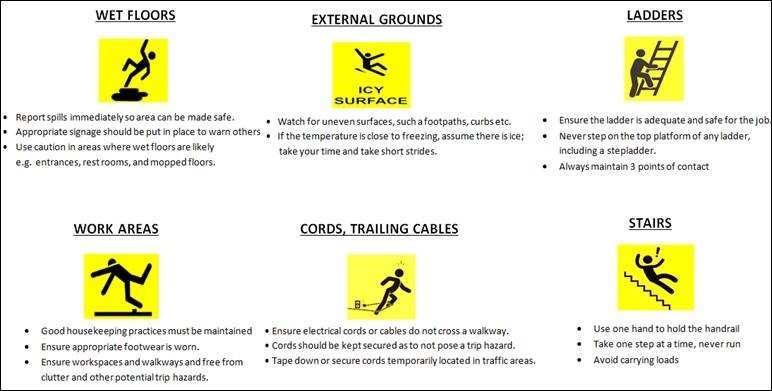Slips, trips and falls are the main cause of accidents in the workplace that result in more than 3 days absence from work.
Preventing slips, trips and falls
Risk assessment
Managers must ensure that slip, trip and fall hazards are risk assessed and controls implemented to eliminate or adequately reduce the risk. The results must be communicated to staff.
When completing your risk assessment, consider the work activity, work area, environmental conditions, and the following.
External areas
Entrances, ambulance bays, and car parks must be kept clear and well maintained. Poor lighting, uneven paving, and wet leaves can increase the risk of falls for staff, service users, and visitors.
Severe weather
Rain, ice, and snow create major hazards at entrances and walkways. This is where service users can be especially vulnerable due to their frailty, using wheelchairs, sticks, or walking frames. Gritting, matting, and regular checks are essential.
Internal areas
Within healthcare settings, corridors, wards, waiting rooms, and treatment areas are busy spaces with high traffic. Hazards such as cluttered trolleys, dropped items, or uneven flooring can cause slips and trips, particularly for those with reduced mobility.
Wet areas (kitchens, bathrooms, wet rooms)
Showers, bathrooms, sluice rooms, and kitchens are high risk due to water on floors. Slip-resistant flooring, hand rails, cleaning schedules, and staff awareness help to protect staff and service users.
Spillages
In clinical areas, spills of water, body fluids, or medicines are immediate slip risks. Spills should be dealt with quickly using appropriate equipment. Spill procedures are critical to maintain safety.
Flooring
In healthcare, floor coverings must balance hygiene with safety. Smooth, cleanable flooring can become slippery when wet. Use slip-resistant flooring. Maintain it in good condition, and repair damage promptly. This will help keep the slip resistancy effective.
Trailing cables and leads
Medical equipment often requires temporary cabling for monitors, infusion pumps, and cleaning machines. These must be positioned safely and away from walkways, or secured with cable covers or trunking.
Housekeeping
Good housekeeping underpins safety in healthcare. Beds, wheelchairs, clinical trolleys, and other equipment should not be placed in corridors or near fire exits. Prompt waste removal and secure storage facilities reduce trip hazards.
Safety signs
Temporary warning signs, such as 'wet floors during cleaning', are essential in healthcare. They should not be overused, as this can reduce their impact. Signs should be clear, well-placed, and removed once the hazards are no longer present.
Diagram with tips and guidance:

Risk assessment worked examples
NHSF Worked Example Slips, Trips and Falls Risk Assessment for Outdoor Area (PDF, 265 KB, 4 pages)
Hazard mapping to reduce slips, trips, and falls
Slips, trips, and falls are among the most preventable incidents in healthcare. Hazard mapping highlights risk areas, tracks incident frequency, and reveals emerging patterns. This proactive approach will help you take targeted action to improve safety and reduce incidents.
When to use hazard mapping
- During risk assessments
- After an incident or near miss
- During staff safety consultations
- When layouts or processes change
- As part of ongoing safety campaigns
These points are further explained in the NHSF Safety Advisory Guidance Note on Preventing Slips, Trips and Falls (PDF, 170 KB, 5 pages).
How to map slips, trips, and falls hazards in 4 simple steps
Step 1: Create a workplace map
Start with a basic sketch of your work environment. Just a rough layout that captures key areas.
Step 2: Identify high risk zones
Mark the locations where slips, trips, or falls are likely to happen. Be sure to consult with staff.
Step 3: Plot past incidents
Identify the locations where previous incidents happened. Use distinct symbols or colours to make them stand out, so you can spot trends.
Step 4: Implement safety controls
Use your completed map to identify additional controls such as:
- repairing flooring
- enhancing cleaning routines
- installing slip-resistant materials
- providing additional equipment
Hazard mapping worked examples
NHSF Worked Example Hazard Mapping in Catering Department (PDF, 130 KB, 1 page)
NHSF Preventing Slips, Trips and Falls in Catering Poster (PDF, 966 KB, 1 page)
Related documents
Generic Risk Assessment Form (Word, 33 KB, 2 pages)
Generic Risk Assessment Fillable Form Template (Word, 132 KB, 2 pages)
NHSF Fast facts Slips, Trips and Falls (PDF, 1.4 MB, 2 pages)
NHSF Check List Slips, Trips and Falls (Word, 47 KB, 5 pages)
NHSF Safety Advisory Guidance Note on Preventing Slips, Trips and Falls (PDF, 168 KB, 5 pages)
More information
More information on slips, trips and falls hazards - hsa.ie.
Contact HSE Health and Safety helpdesk (HSE staff only)
Use the Health and Safety Self Service Portal
Phone: 1800 420 420
Monday to Friday 10.30am to 12 noon and 2.00pm to 3.30pm